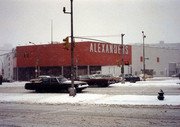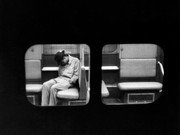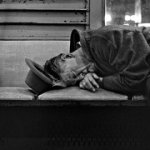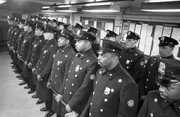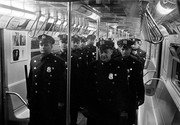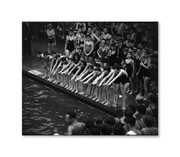You are using an out of date browser. It may not display this or other websites correctly.
You should upgrade or use an alternative browser.
You should upgrade or use an alternative browser.
Remember When These Used to Be Here in NYC
- Thread starter mack
- Start date
- Joined
- Aug 29, 2008
- Messages
- 2,487
Ray, I do remember Dominican Commercial ;D
Gone - American Chicle factory - "Chicklet Gum" and "Dentine Gum" factory at 30-30 Thomson Ave. in Long Island City - explosion in 1976 - closed in 1981 - gone 1600 jobs
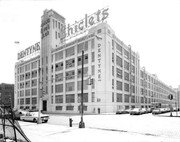
http://www.qchron.com/qboro/i_have_...cle_04aa2623-966f-5ee2-b5ea-33b8df89e2dc.html
Explosion: Dozens Hurt In Gum Blast
NEW YORK (UPI) - An apparent chemical explosion at a Chiclets chewing gum factory Sunday injured dozens of workers, many of them severely burned. Twenty-eight of the 48 employes hurt in the mishap were reported in serious or critical condition, authorities said, and one was said to be near death with second-and third-degree burns over 90 per cent of his body. All told, 30 victims were reported hospitalized and some had to be flown by Army helicopter as far away as Chester, Pa., and Philadelphia for proper burn treatment facilities because budget restrictions have resulted in operations cutbacks at burn centers at New York?s municipal hospitals. Fire officials said they believe ?chemical dust? apparently was ignited at about 2:45 a.m. Sunday, causing an explosion that blew out a wall in the fourth-floor vat room where about 150 employes were working. The blast, which flung some employes across the large room, also ignited a fire that added to the damage of the factory, which takes up an entire city block. The factory, open around the clock, is owned by the American Chicle Division of the Warner Lambert Co. The injured worked the midnight to 8 a m. shift. - Desert Sun, 22 November 1976

http://www.qchron.com/qboro/i_have_...cle_04aa2623-966f-5ee2-b5ea-33b8df89e2dc.html
Explosion: Dozens Hurt In Gum Blast
NEW YORK (UPI) - An apparent chemical explosion at a Chiclets chewing gum factory Sunday injured dozens of workers, many of them severely burned. Twenty-eight of the 48 employes hurt in the mishap were reported in serious or critical condition, authorities said, and one was said to be near death with second-and third-degree burns over 90 per cent of his body. All told, 30 victims were reported hospitalized and some had to be flown by Army helicopter as far away as Chester, Pa., and Philadelphia for proper burn treatment facilities because budget restrictions have resulted in operations cutbacks at burn centers at New York?s municipal hospitals. Fire officials said they believe ?chemical dust? apparently was ignited at about 2:45 a.m. Sunday, causing an explosion that blew out a wall in the fourth-floor vat room where about 150 employes were working. The blast, which flung some employes across the large room, also ignited a fire that added to the damage of the factory, which takes up an entire city block. The factory, open around the clock, is owned by the American Chicle Division of the Warner Lambert Co. The injured worked the midnight to 8 a m. shift. - Desert Sun, 22 November 1976
Last edited:
Gone - IRT Third Avenue Line
The IRT Third Avenue Line, commonly known as the Third Avenue El and the Bronx El, was an elevated railway in Manhattan and the Bronx, New York City. Originally operated by the New York Elevated Railway, an independent railway company, it was acquired by the Interborough Rapid Transit Company (IRT) and eventually became part of the New York City subway system.
The first segment of the line, with service at most stations, opened from South Ferry to Grand Central Depot on August 26, 1878.[1] Service was extended to Harlem in Manhattan on December 30. Service in Manhattan was phased out in the early 1950s and closed completely on May 12, 1955, and ended in the Bronx on April 29, 1973. The Third Avenue El was the last elevated line to operate in Manhattan, other than the 1 train on the IRT Broadway?Seventh Avenue Line (which has elevated sections between 122nd and 135th Streets and north of Dyckman Street), and was a frequent backdrop for movies. Service on the Second, Sixth and Ninth Avenue El lines was terminated in 1942, 1938, and 1940, respectively.
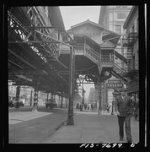
The IRT Third Avenue Line, commonly known as the Third Avenue El and the Bronx El, was an elevated railway in Manhattan and the Bronx, New York City. Originally operated by the New York Elevated Railway, an independent railway company, it was acquired by the Interborough Rapid Transit Company (IRT) and eventually became part of the New York City subway system.
The first segment of the line, with service at most stations, opened from South Ferry to Grand Central Depot on August 26, 1878.[1] Service was extended to Harlem in Manhattan on December 30. Service in Manhattan was phased out in the early 1950s and closed completely on May 12, 1955, and ended in the Bronx on April 29, 1973. The Third Avenue El was the last elevated line to operate in Manhattan, other than the 1 train on the IRT Broadway?Seventh Avenue Line (which has elevated sections between 122nd and 135th Streets and north of Dyckman Street), and was a frequent backdrop for movies. Service on the Second, Sixth and Ninth Avenue El lines was terminated in 1942, 1938, and 1940, respectively.

There have been few uniforms in any service cooler looking than the NYPD winter great coat (with the Blackwatch lining) shown in the photo above or their high-collar tunics which are still worn by the NYPD Honor Guard. They made even overweight hairbags look imposing and respectable...until summer came and the coats and tunics were in the lockers. No offense to anyone, but you know I'm right.
- Joined
- May 6, 2010
- Messages
- 17,339
Yes certainly rember the 3rd Ave El in the early '50s ....lived almost along side it ....My Father OTJ & a Union Supporter would send me to a Union Bakery on Third under the El for a loaf of rye bread....as much as i was gratified that i was allowed to go to the store by myself ....on one Sunday it was really raining & i thought well walking another block up Third was not really necesary so i bought a loaf from the bakery a block closer....(now back then a Union Bakery had a Postage Stamp looking thing pasted on the loaf from a Union Bakery & when they sliced the loaf in the machine it cut right thru the little stamp) so here i come home with a loaf without the Stamp !.....well wasted trip then repeated & a lesson learned .mack said:Gone - IRT Third Avenue Line
The IRT Third Avenue Line, commonly known as the Third Avenue El and the Bronx El, was an elevated railway in Manhattan and the Bronx, New York City. Originally operated by the New York Elevated Railway, an independent railway company, it was acquired by the Interborough Rapid Transit Company (IRT) and eventually became part of the New York City subway system.
The first segment of the line, with service at most stations, opened from South Ferry to Grand Central Depot on August 26, 1878.[1] Service was extended to Harlem in Manhattan on December 30. Service in Manhattan was phased out in the early 1950s and closed completely on May 12, 1955, and ended in the Bronx on April 29, 1973. The Third Avenue El was the last elevated line to operate in Manhattan, other than the 1 train on the IRT Broadway?Seventh Avenue Line (which has elevated sections between 122nd and 135th Streets and north of Dyckman Street), and was a frequent backdrop for movies. Service on the Second, Sixth and Ninth Avenue El lines was terminated in 1942, 1938, and 1940, respectively.

- Joined
- Aug 29, 2008
- Messages
- 2,487
The tunic that you refer to was known as the "winter blouse."manhattan said:There have been few uniforms in any service cooler looking than the NYPD winter great coat (with the Blackwatch lining) shown in the photo above or their high-collar tunics which are still worn by the NYPD Honor Guard. They made even overweight hairbags look imposing and respectable...until summer came and the coats and tunics were in the lockers. No offense to anyone, but you know I'm right.
Gone - most local neighborhood bakeries - now baked goods come from large supermarket chains
New York Bakeries
In 1946 almost every neighborhood in New York City had a bakery or two along the main drag. Some were independent and some were part of a chain. Bakery trucks plied the streets of the outer boroughs delivering bread, cake, donuts and pies to the doors of housewives. The home delivery trucks were still around in the suburbs when I was a little kid in the 1950s. I remember the Dugan man, with his coffee cakes and, at Easter time, hot cross buns, knocking at the back door in the morning. At my grandmother's house in Queens, it was Krug's who delivered.
In Arthur Schwartz's New York Foods, Schwartz points out that the donuts and crullers were around since New York was New Amsterdam but the bakery explosion dated to the arrival of the Germans. In ethnic neighborhoods you could find bakeries offering up the baked goods of the homeland whether it was Italy, Sweden, Hungary, Poland or somewhere else. Jewish bakeries proliferated in Jewish neighborhoods. Snooty neighborhoods had their French pastry shops. But German bakeries were everywhere. In Yorkville, bakeries served strudels, pastries and cakes that you could take home or eat on the premises with a cup of strong coffee or tea at cafe tables just like in Mitteleuropa. Mrs. Herbst was the most celebrated and visited even by the rich and famous for its strudel.
One of the specialties of the Jewish bakeries was kaiser rolls even more popular on a Sunday morning than bagels were in the Forties. And kaiser rolls were not enjoyed only by Jews. It was a common choice for sandwiches as well as for breakfast. These were not the soft sandwich rolls passed off as kaisers in supermarkets nowadays. Real kaiser rolls have a crisp, hard, thin outer crust that was laden with poppy seeds and a soft, light interior, perfect with a big glob of butter but also great filled with cold cuts or eggs as well. They were best when they were not long from the oven. Schwartz wrote that German rye with caraway or nigella seeds was the quintessential local bread, associated with the city to many visitors.
Bakeries offered more than bread. Some favorite cakes were black and whites, a yellow cake topped half with chocolate and half with vanilla icing. Ebingers in Brooklyn and Queens was known for its blackout cake, a chocolate cake with crumbs and a chocolate filling. Nesselrode pie was immensely popular in the Forties. It included rum, chestnuts, candied fruit, Bavarian cream and chocolate curls.
Besides Ebingers, where the women behind the counter had German accents, other popular bakeries included Drake's, Cushman's, Pectors and Entenmann's, now a supermarket favorite. Department stores like Macy's and Altman's also had bakery counters back then. The newspapers this week carried ads from Hanscom bakeries, with outlets throughout the city, for its egg-shaped Easter cakes filled with chocolate butter cream, iced with chocolate and decorated with flowers. Hot cross buns were abundant this year after a wartime scarcity. But continued scarcity of flour and sugar meant there were fewer sweet cakes and some of the white bread on sale had a grayish color and whole grain taste not preferred at the time.
New York Bakeries
In 1946 almost every neighborhood in New York City had a bakery or two along the main drag. Some were independent and some were part of a chain. Bakery trucks plied the streets of the outer boroughs delivering bread, cake, donuts and pies to the doors of housewives. The home delivery trucks were still around in the suburbs when I was a little kid in the 1950s. I remember the Dugan man, with his coffee cakes and, at Easter time, hot cross buns, knocking at the back door in the morning. At my grandmother's house in Queens, it was Krug's who delivered.
In Arthur Schwartz's New York Foods, Schwartz points out that the donuts and crullers were around since New York was New Amsterdam but the bakery explosion dated to the arrival of the Germans. In ethnic neighborhoods you could find bakeries offering up the baked goods of the homeland whether it was Italy, Sweden, Hungary, Poland or somewhere else. Jewish bakeries proliferated in Jewish neighborhoods. Snooty neighborhoods had their French pastry shops. But German bakeries were everywhere. In Yorkville, bakeries served strudels, pastries and cakes that you could take home or eat on the premises with a cup of strong coffee or tea at cafe tables just like in Mitteleuropa. Mrs. Herbst was the most celebrated and visited even by the rich and famous for its strudel.
One of the specialties of the Jewish bakeries was kaiser rolls even more popular on a Sunday morning than bagels were in the Forties. And kaiser rolls were not enjoyed only by Jews. It was a common choice for sandwiches as well as for breakfast. These were not the soft sandwich rolls passed off as kaisers in supermarkets nowadays. Real kaiser rolls have a crisp, hard, thin outer crust that was laden with poppy seeds and a soft, light interior, perfect with a big glob of butter but also great filled with cold cuts or eggs as well. They were best when they were not long from the oven. Schwartz wrote that German rye with caraway or nigella seeds was the quintessential local bread, associated with the city to many visitors.
Bakeries offered more than bread. Some favorite cakes were black and whites, a yellow cake topped half with chocolate and half with vanilla icing. Ebingers in Brooklyn and Queens was known for its blackout cake, a chocolate cake with crumbs and a chocolate filling. Nesselrode pie was immensely popular in the Forties. It included rum, chestnuts, candied fruit, Bavarian cream and chocolate curls.
Besides Ebingers, where the women behind the counter had German accents, other popular bakeries included Drake's, Cushman's, Pectors and Entenmann's, now a supermarket favorite. Department stores like Macy's and Altman's also had bakery counters back then. The newspapers this week carried ads from Hanscom bakeries, with outlets throughout the city, for its egg-shaped Easter cakes filled with chocolate butter cream, iced with chocolate and decorated with flowers. Hot cross buns were abundant this year after a wartime scarcity. But continued scarcity of flour and sugar meant there were fewer sweet cakes and some of the white bread on sale had a grayish color and whole grain taste not preferred at the time.
- Joined
- Mar 8, 2007
- Messages
- 5,392
memory master said:The tunic that you refer to was known as the "winter blouse."manhattan said:There have been few uniforms in any service cooler looking than the NYPD winter great coat (with the Blackwatch lining) shown in the photo above or their high-collar tunics which are still worn by the NYPD Honor Guard. They made even overweight hairbags look imposing and respectable...until summer came and the coats and tunics were in the lockers. No offense to anyone, but you know I'm right.
Last edited by a moderator:
- Joined
- Aug 29, 2008
- Messages
- 2,487
G-man, did you receive the pm I sent you a day or so ago? Nothing urgent, just wondered if you got it.
- Joined
- Mar 8, 2007
- Messages
- 5,392
Yes, just saw itmemory master said:G-man, did you receive the pm I sent you a day or so ago? Nothing urgent, just wondered if you got it.
- Joined
- Sep 12, 2009
- Messages
- 885
guitarman314 said:https://www.youtube.com/watch?v=7UW3ZjYVskkmemory master said:The tunic that you refer to was known as the "winter blouse."manhattan said:There have been few uniforms in any service cooler looking than the NYPD winter great coat (with the Blackwatch lining) shown in the photo above or their high-collar tunics which are still worn by the NYPD Honor Guard. They made even overweight hairbags look imposing and respectable...until summer came and the coats and tunics were in the lockers. No offense to anyone, but you know I'm right.
Gman,
Thanks very much for showing this video ? an absolutely great historical document. It?s surprising how many buildings, especially, but not only, in lower Manhattan are still in place. I think the ?HOTEL? sign opposite Cooper Union is still there, as an example. Probably only a few years at best until the developers get hold of them.
It?s also nice to see imagery of industrial areas of the city when we were a major manufacturing and transportation center. And hat off to whoever compiled, edited and narrated the film.
Oh, and I also noticed the cop in his greatcoat at about 22:19.
Great work as usual, Gman!
Gone - paperboys or papergirls delivering newspapers - before school or after school and weekends - everyday - Sunday deliveries were the worst because the funnies and ads made the paper so big - dogs chased you, especially the little ones who were always waiting for you - the worst neighbors always complained the most, wanted their paper hand-delivered, and gave no tip - your bike got flats and you had a patch kit for the inner tube and a hand pump that you also could use to blow up your football and basketball - your pockets were full of change days you collected - the worst neighbors also gave you pennies when you collected - you walked when it snowed
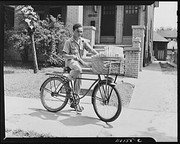



Remember the FULL SERVICE GAS STATION. Where we could buy gasoline at 23.9 cents a gallon. Have an attendant pump our gas, plus have our windshield cleaned, car vacuumed, oil, radiator, and battery checked. All included for that 23.9 cents a gallon.
And for every fill up given a special gift. Sometimes it was a glass, other times a dinner plate or cup. And on top of that, some gasoline stations even gave "green stamps" for more free gifts. Fill up a couple of those green stamp books and get some Christmas gifts for the family - at no charge.
Along comes the OPEC Energy Crisis of the 1970s. And with that comes the long gasoline lines that went around corners and grew for blocks. Everybody waiting their turn to get their gas tank filled up. Of course the price of gasoline had more than doubled, from 23.9/gal to 70 cents a gallon, and even more. But even with that big increase, if we were able to get the gas, we were happy.
We could only buy gas according to the last number or letter of our license plate every other day.
Here's a reminder of those FULL SERVICE GAS STATIONS and the kind of service we got. For the younger members of this site, Yes, this really is the way it was.
Today with the use of "online banking" and ATM machines, could the banking industry follow soon. Customer Service as we know it today, become a thing of the past ? Even our supermarkets and major stores with self service check out. Much like our Full Service Gas Stations.
This is the way it was at the local gasoline station.
www.youtube.com/watch?v=Kr7wv5TpODY
And for every fill up given a special gift. Sometimes it was a glass, other times a dinner plate or cup. And on top of that, some gasoline stations even gave "green stamps" for more free gifts. Fill up a couple of those green stamp books and get some Christmas gifts for the family - at no charge.
Along comes the OPEC Energy Crisis of the 1970s. And with that comes the long gasoline lines that went around corners and grew for blocks. Everybody waiting their turn to get their gas tank filled up. Of course the price of gasoline had more than doubled, from 23.9/gal to 70 cents a gallon, and even more. But even with that big increase, if we were able to get the gas, we were happy.
We could only buy gas according to the last number or letter of our license plate every other day.
Here's a reminder of those FULL SERVICE GAS STATIONS and the kind of service we got. For the younger members of this site, Yes, this really is the way it was.
Today with the use of "online banking" and ATM machines, could the banking industry follow soon. Customer Service as we know it today, become a thing of the past ? Even our supermarkets and major stores with self service check out. Much like our Full Service Gas Stations.
This is the way it was at the local gasoline station.
www.youtube.com/watch?v=Kr7wv5TpODY
- Joined
- May 6, 2010
- Messages
- 17,339
^^^^Cheapest gas i remember was in the early '60s .19 cents a gallon at a station on the hill at the beginning of Bushwick Ave just before Broadway Junction....it was right next to Earl Schieb were you could get your car repainted for $19.95 Take me back !

